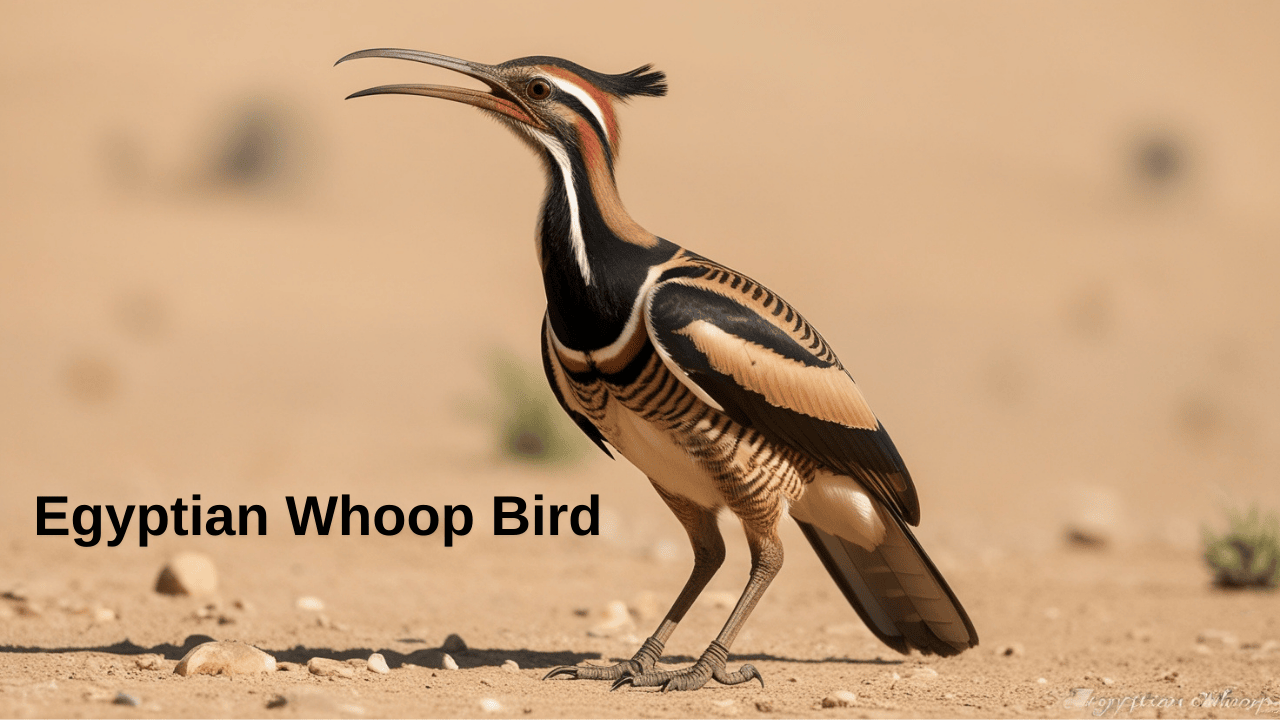The Egyptian Whoop Bird, also known as the “Eurasian Hoopoe” (Upupa epops), is a fascinating avian species that captures the imagination of bird enthusiasts and casual observers alike. With its striking plumage, unique call, and intriguing behavior, the hoopoe stands out among the rich tapestry of birds found in Egypt and across Europe, Asia, and Africa.
Physical Characteristics
The Egyptian Whoop Bird is easily recognizable due to its distinctive appearance. Key features include:
- Crest: The hoopoe has a prominent crest made up of elongated feathers that can be raised or lowered, adding to its charm.
- Coloration: Its plumage is primarily a warm, reddish-brown with black and white patterns on the wings and tail. The underparts are lighter, giving it a striking contrast.
- Beak: The long, slender beak is perfect for probing the ground for insects and other invertebrates, which make up the majority of its diet.
Habitat and Distribution
The Egyptian Whoop Bird thrives in a variety of habitats, including:
- Open Fields: It prefers open grasslands and agricultural fields where it can forage for food.
- Woodlands: The hoopoe can also be found in wooded areas, especially those with open spaces that provide a mix of shade and sun.
- Urban Areas: Surprisingly adaptable, the hoopoe can be seen in parks and gardens, often drawn to human activity that disturbs the soil, revealing hidden insects.
This bird is widely distributed across Europe, North Africa, and parts of Asia, migrating to warmer regions during the winter months.
Behavior and Diet
The Egyptian Whoop Bird is known for its unique behavior, including:
- Foraging: It uses its long beak to probe the ground, searching for insects, larvae, and other small invertebrates. It is also known to eat seeds and fruits.
- Nesting: Hoopoes typically nest in tree cavities, rock crevices, or even in human-made structures. The female lays between 4 to 8 eggs, which she incubates for about 15 days.
- Vocalizations: The hoopoe is famous for its distinctive “hoop” call, which is both a mating call and a way to establish territory. This call can be heard during courtship displays and throughout the breeding season.
Cultural Significance
The Egyptian Whoop Bird has a rich cultural history in various civilizations. In ancient Egypt, the hoopoe was revered and often associated with the sun god Ra. Its striking appearance and unique behaviors have led to its representation in art and literature throughout the ages. Today, the hoopoe remains a symbol of beauty and resilience, inspiring artists and poets alike.
The Egyptian Whoop Bird, also known as the Eurasian Hoopoe (Upupa epops), is a fascinating avian species that captures the imagination of bird enthusiasts and casual observers alike. With its striking plumage, unique call, and intriguing behavior, the hoopoe stands out among the rich tapestry of birds found in Egypt and across Europe, Asia, and Africa.
Distinctive Crest
The hoopoe has a prominent crest made up of elongated feathers that can be raised or lowered, adding to its charm.
Vibrant Coloration
Its plumage is primarily a warm, reddish-brown with black and white patterns on the wings and tail. The underparts are lighter, giving it a striking contrast.
Unique Beak
The long, slender beak is perfect for probing the ground for insects and other invertebrates, which make up the majority of its diet.
Habitat and Distribution
The Egyptian Whoop Bird thrives in a variety of habitats, including:
- Open Fields: It prefers open grasslands and agricultural fields where it can forage for food.
- Woodlands: The hoopoe can also be found in wooded areas, especially those with open spaces that provide a mix of shade and sun.
- Urban Areas: Surprisingly adaptable, the hoopoe can be seen in parks and gardens, often drawn to human activity that disturbs the soil, revealing hidden insects.
Geographic Range
This bird is widely distributed across Europe, North Africa, and parts of Asia, migrating to warmer regions during the winter months.
Foraging Techniques
The Egyptian Whoop Bird is known for its unique behavior, including:
- Foraging: It uses its long beak to probe the ground, searching for insects, larvae, and other small invertebrates. It is also known to eat seeds and fruits.
Nesting Habits
Hoopoes typically nest in tree cavities, rock crevices, or even in human-made structures. The female lays between 4 to 8 eggs, which she incubates for about 15 days.
Vocalizations
The hoopoe is famous for its distinctive “hoop” call, which is both a mating call and a way to establish territory. This call can be heard during courtship displays and throughout the breeding season.
Cultural Significance
The Egyptian Whoop Bird has a rich cultural history in various civilizations. In ancient Egypt, the hoopoe was revered and often associated with the sun god Ra.
Artistic Representation
Its striking appearance and unique behaviors have led to its representation in art and literature throughout the ages. Today, the hoopoe remains a symbol of beauty and resilience, inspiring artists and poets alike.
Threats to the Species
The Egyptian Whoop Bird faces various threats, including habitat loss and climate change. Conservation efforts are essential to protect this unique species and its habitat.
Protection Efforts
Various organizations are working to raise awareness about the importance of conserving the hoopoe’s habitat and ensuring its survival for future generations.
FAQs About the Egyptian Whoop Bird
Q1: What does the Egyptian Whoop Bird eat?
A1: The Egyptian Whoop Bird primarily feeds on insects, larvae, and other invertebrates. It may also consume seeds and fruits.
Q2: How can I identify an Egyptian Whoop Bird?
A2: Look for its distinctive crest, reddish-brown plumage with black and white patterns, and a long, slender beak. Its unique “hoop” call is also a good identifying feature.
Q3: Where does the Egyptian Whoop Bird nest?
A3: Hoopoes typically nest in tree cavities, rock crevices, or even in human-made structures, laying 4 to 8 eggs.
Q4: Is the Egyptian Whoop Bird migratory?
A4: Yes, the hoopoe is migratory and usually moves to warmer regions during the winter months.
Q5: Can I find the Egyptian Whoop Bird in urban areas?
A5: Yes, the Egyptian Whoop Bird is adaptable and can often be found in parks and gardens, especially where there is human activity that disturbs the soil.
Conclusion
The Egyptian Whoop Bird is a captivating species that adds to the biodiversity of Egypt and beyond. With its remarkable adaptations, cultural significance, and unique behaviors, the hoopoe is not only a delight for birdwatchers but also a vital part of the ecosystems it inhabits. As we continue to study and appreciate these enchanting creatures, let us also work to protect their habitats and ensure their survival for future generations.











